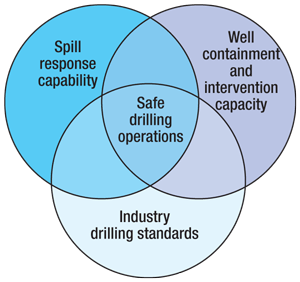|
Vol. 231 No.9 |

|
|
| PRAMOD KULKARNI, EDITOR |
What’s next for the deepwater Gulf of Mexico
I don’t have a crystal ball to gaze into the future. But I attended the 14th Annual Gulf of Mexico Deepwater Technical Symposium on Aug. 19 in New Orleans, and I think I have seen the industry come to terms with the Deepwater Horizon incident and scope out a new scenario for safe deepwater drilling in the Gulf of Mexico. This future relies on the management of change that the industry’s consortium of operators and service companies hopes to execute and—what may be harder to manage—realistic expectations from the US Department of the Interior (DOI) and the US Congress.
 |
Fig. 1. Industry initiatives to restore confidence in deepwater drilling. Courtesy of API Joint Industry Task Force.
|
|
Operator perspective. At the symposium luncheon session, John Hollowell, Shell’s executive vice president for deepwater, made the classic case of the continued importance of fossil fuels to satisfy US energy demand to 2030 and beyond and the fact that 70% of the oil and 36% of gas from the Gulf of Mexico comes from deepwater fields. Asked at what point the operators might put on hold their deepwater Gulf of Mexico projects for opportunities in Brazil or West Africa, Hollowell said that Shell is monitoring the regulatory and legislative environment and, while he couldn’t speak for all the oil companies, what the Gulf operators will do depends on the extent and the length of the moratorium.
Joint industry task forces. At the symposium’s concluding plenary session, a panel of industry experts presented the work of joint industry task forces (JITFs) that the American Petroleum Institute (API) has set up to advise the DOI in the aftermath of the Macondo well blowout. The five JITFs are Deepwater Well Design Task Force, represented by John Peters of Chevron; Deepwater Well Operating Procedures Task Force, represented by George Coltrin of Nexen and Ron Sweatman of Halliburton; Deepwater Well BOP/Equipment Task Force, represented by Moe Plaisiance of Diamond Offshore; Subsea Well Control and Containment Task Force, represented by Charlie Williams of Shell; and Oil Spill Response Task Force, represented by Keith Robson of Marathon.
Changes to API RP 96. The Well Design JITF is identifying best practices associated with cementing, wellbore loads and casing resistance, wellbore barriers, and procedures for displacing wells to lighter fluids. The changes would be made to the API RP 96 standards. Chevron’s John Peters said the JITF may recommend the locking of the casing hanger assembly into the subsea wellhead and a requirement of two or more independent barriers for each well path. When displacing wells to lighter fluids, the JITF is likely to recommend closing the subsea BOP and separate operations for negative test, riser displacement and casing displacement. The drilling contractor and the operator would have to monitor carefully the displacement volumes in and out of the wellbore and ensure the shearability of components across the shear rams.
Well construction interface document. George Coltrin of Nexen said the Well Operating Procedures JITF is recommending the creation of a specific Well Construction Interface Document (WCID) for each well prior to drilling. The WCID will include detailed information about the basis of design, the drilling contractor’s safety case and the lease operator’s safety management system. In the Basis of Design section, there would be specific details on geological and geophysical conditions, well barriers, casing design, well execution plan, critical well risk assessments and the drilling contractor and operator’s management-of-change (MOC) procedures. In the Safety Case section, there would be information on well control procedures, risk management processes, emergency response and procedures for well monitoring, auditing and review.
BOP/equipment changes. Moe Plaisiance of Diamond Offshore said the Well BOP/Equipment JITF is likely to recommend a safety case regime for all wells, a robust management-of-change (MOC) process, addition of autoshear or deadman switches for floating rigs, the use of API Spec 17H ROV stabs to enable remote vehicles to operate subsea controls in case of a blowout, and the evaluation of current technology for acoustic BOP control systems.
Subsea well control. Charlie Williams of Shell presented the initial concept of a Marine Well Containment Co. (MWCC) project that would result in the development of a flexible and adaptable subsea containment system consisting of equipment connected by risers to vessels to safely capture, store and offload the oil from a blowout. The three subgroups within the JITF are Well Containment at the Seafloor; Intervention and Containment within the Subsea Well and Subsea Collection; and Surface Processing and Storage.
Oil spill response. Marathon’s Keith Robson explained how the Oil Spill Response JITF will focus on oil spill planning, mechanical recovery and containment, shoreline protection and cleanup, surface and subsurface dispersants, oil sensing and tracking, in situ burning and alternative spill control technologies. The JITF made its initial report to congressional committees in July and plans to provide midterm suggestions in late August and a long-term strategy at the end of 2010 to the presidential commission, the US Coast Guard and the DOI.
Will the DOI listen? Plaisiance said the DOI’s Bureau of Ocean Energy Management, Regulation and Enforcement accepted 70% of the JITF recommendations when it issued its guidelines in June. So I guess we’re still in the 30% zone of uncertainty for the future of deepwater drilling in the Gulf of Mexico. 
|





